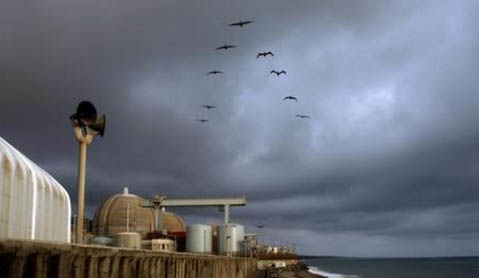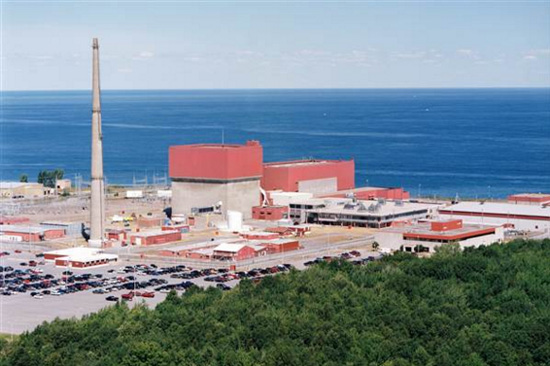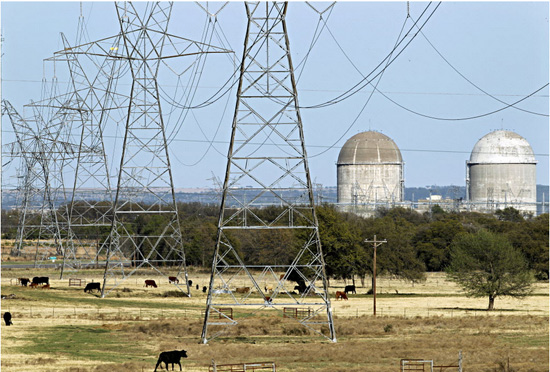Archive for the ‘Nukes’ Category
Editorial The solution to storing San Onofre’s spent nuclear fuel
November 30, 2015
The Los Angeles Times Editorial Board

Pelicans fly in formation over the decommissioned
San Onofre Nuclear Generating Station
Tuesday, March 25, 2014. (Los Angeles Times)
No one really likes the idea of storing spent nuclear fuel rods at the edge of the mighty Pacific Ocean, even if they are sealed in stainless steel canisters, encased in concrete and partially buried. What would happen to the millions of people living within 50 miles, or the Pacific’s marine life, if there were a leak or an accident? What would happen if California were hit with a tsunami like the one that caused the Fukushima Daiichi nuclear power plant disaster in Japan in 2011?
This is the sort of fearful speculation that has emerged since Southern California Edison revealed its plan to store spent fuel rods from the decommissioned San Onofre Nuclear Generating Station on the power plant’s grounds rather than at a federally approved nuclear waste disposal site. The reason: No such facility exists. You can thank the federal government, and Sen. Harry Reid (D-Nev.) in particular, for that.
This nation approved and built nuclear plants without ever providing a safe place for their waste to be stored.
This nation approved and built nuclear plants without ever providing a safe place for their waste to be stored, knowing all along that it would remain lethally radioactive for thousands of years. Congress settled on a site for a national nuclear waste repository — Yucca Mountain, deep in the wilderness of Nevada — but the project stalled in 2009 after the Obama administration formally opposed it. That fulfilled a promise candidate Barack Obama had made to Reid and voters in Nevada, a key swing state.
Some members of Congress are pushing to get funding as early as next year to test out privately-run temporary storage facilities for spent fuel rods. But even if lawmakers fund the projects now, it would take a decade or longer to get the sites approved and built.
This leaves no real option for San Onofre other than nuclear beach bunkers. The California Coastal Commission came to the same conclusion last month when it approved Edison’s plan to store 75 canisters on site until an off-site waste station is built. San Onofre has been storing its spent fuel rods on site without issue for decades.
Residents of Orange and San Diego counties have long had an uneasy relationship with the beachfront nuclear plant, which is perched near a coastal fault line. So community activists and environmentalists celebrated when San Onofre was officially decommissioned in 2013 after equipment troubles shut down its last two reactors.
Now that the reactors are turned off, however, the public health threat is dramatically reduced because there’s no opportunity for a catastrophic meltdown. The waste storage containers are built to withstand tsunamis and earthquakes. Still, a handful of activists aren’t satisfied and have sued to reverse the Coastal Commission’s approval. They would prefer that the spent fuel rods be packed up and shipped via truck to the Palo Verde nuclear plant in Tonopah, Ariz., in which Edison has a minority stake.
But Palo Verde’s license from the Nuclear Regulatory Commission allows the plant to store only its own spent rods, not those from other plants. Also, the Palo Verde plant is on the outskirts of Phoenix, whose residents would hardly welcome the idea. And then there’s the peril of sending trucks loaded with nuclear waste through one of the nation’s most congested freeway systems.
If a judge puts Edison’s plans on hold, it could leave the coast more vulnerable by delaying construction of the steel canisters and concrete bunkers. Right now, the spent fuel rods are being kept in cooling pools, which were intended for only temporary storage. Dry-cask storage provides more long-term protection against such risks as rising oceans and terrorism. It’s safer to pack them into canisters than to let them linger in the pools while the litigation plays out.
If San Onofre opponents want to hasten the departure of the fuel rods, they should instead lobby federal lawmakers to open Yucca Mountain. They could also throw their support behind legislation by Sen. Dianne Feinstein (D-Calif.) and other senators that would lay out a comprehensive plan for storing waste from the country’s decommissioned nuclear energy plants. The bill’s prospects are unclear, as it has yet to be heard in the Senate Natural Resources Committee.
In Congress, the safe disposal of nuclear waste apparently doesn’t rank as a priority. That won’t change until enough concerned Americans demand better solutions to the problems posed by reactors’ highly radioactive trash.
This document contains copyrighted material whose use has not been specifically authorized by the copyright owner. SEED Coalition is making this article available in our efforts to advance understanding of ecological sustainability, human rights, economic democracy and social justice issues. We believe that this constitutes a "fair use" of the copyrighted material as provided for in section 107 of the US Copyright Law. If you wish to use this copyrighted material for purposes of your own that go beyond "fair use", you must obtain permission from the copyright owner.
Entergy Announces Second Nuclear Plant Closure in Less Than a Month
November 2, 2015
Associated Press
SCRIBA, N.Y. — Entergy Corp. says it plans to close the James A. FitzPatrick nuclear power plant on Lake Ontario.
The company announced the move Monday and says the decision is based on the deteriorating economics of the facility — reduced plant revenues due to low natural gas prices, poor market design and high operational costs.

The James A. FitzPatrick nuclear power plant, located in Scriba, New York, is to be closed. U.S. Nuclear Regulatory Commission
The company says the facility, which has an annual payroll of $74 million and pays more than $17 million in taxes, is losing around $60 million annually.
Barring intervention by state officials, the 850-megawatt facility in Scriba, New York, will shut down in late 2016 or early 2017 and begin laying off its 615 employees.
FitzPatrick began generating electricity in 1975 and produces enough electricity to power more than 800,000 homes. Scriba is about 40 miles north of Syracuse.
It is the second closure of a U.S. nuclear plant announced by Entergy in less than a month.
On Oct. 13, the company said it would shut the Pilgrim Nuclear Power Station in Plymouth, Massachusetts, by June 2019.
A statement announcing the closure of the only commercial nuclear plant in the state cited “poor market conditions, reduced revenues and increased operational costs.”
This document contains copyrighted material whose use has not been specifically authorized by the copyright owner. SEED Coalition is making this article available in our efforts to advance understanding of ecological sustainability, human rights, economic democracy and social justice issues. We believe that this constitutes a "fair use" of the copyrighted material as provided for in section 107 of the US Copyright Law. If you wish to use this copyrighted material for purposes of your own that go beyond "fair use", you must obtain permission from the copyright owner.
Judge clears Energy Future to move ahead on selling Oncor to Hunts
September 17, 2015
James Osborne
Dallas Morning News

Transmission lines lead to Luminant’s Comanche Peak Nuclear Power Plant near Glen Rose, Texas. (Tom Fox/The Dallas Morning News)
WILMINGTON, Del. — Almost 18 months after filing for bankruptcy, Texas’ largest power operator Energy Future Holdings was cleared Thursday to move ahead on its plan to break up the company and settle its $40 billion in debts.
With hopes of getting out of court by spring, Energy Future plans to hand its power plants and the retail business TXU Energy to senior creditors, while the transmission business Oncor will be sold to a group led by Dallas billionaire Ray L. Hunt.
It was a quiet conclusion to what had the makings of a potentially high-stakes showdown between Energy Future and an aggressive group of creditors arguing the current restructuring plan is unlikely to succeed. By the time teams of dark-suited attorneys made their way into court Thursday morning though, the two sides had agreed to a temporary truce.
Smaller disagreements would be put aside, leaving the larger question of whether Energy Future was fairly paying off its creditors with what assets it has left to a trial in November.
"We’re happy to cede the battleground today," said Andrew Dietderich, an attorney representing the opposing creditors group. "Our objection is stronger than ever."
The case marks the inglorious end to what remains the largest leveraged buyout in U.S. history. Led by private equity tycoons Henry Kravis and David Bonderman, in 2007 the shareholders of TXU Corp., which served millions of customers across Texas, agreed to sell the company for $45 billion.
But saddled with so much debt, the company quickly fell into financial trouble when natural gas prices — which set the price of electricity in Texas — started to fall, as hydraulic fracturing operations across Texas and Pennsylvania flooded the marketplace with gas.

The entrance to the U.S. Bankruptcy Court in Wilmington, Del. (James Osborne/Staff Writer)
Now every couple weeks attorneys from New York and Dallas file up to the fifth floor of a nondescript red brick building in downtown Wilmington to argue over what’s left of what had been one of Texas’ oldest and most recognizable companies.
One of the busiest courts in the country for corporate bankruptcies, the Delaware district has become like a second home to those who operate in the arcane but lucrative field. Sitting shoulder to shoulder on dark-wooden benches Thursday, attorneys racking up hundreds if not thousands of dollars for the appearance speculated on the day’s developments.
"If everything goes right it could be be done by April, but I don’t know," said Harold Kaplan, a Chicago-based attorney. "Everyone’s still doing staring contests."
The question is whether the deal to sell Oncor, which serves more than 3 million customers across North and West Texas, will go through. Hunt and his partners want to place the power line company into what is termed a real estate investment trust, essentially a means to shift income tax liability from the company to its shareholders.
Only a utility on the scale of Oncor has never been operated under such a structure, tax experts say.
Hunt and his son Hunter, who helps run Hunt Consolidated and launched the power line business Sharyland Utilities in 1999, are counting on Oncor generating enough income to support a purchase price valued between $18 and $19 billion. But first they will need to persuade the Texas Public Utility Commission, which sets rates for the transmission and distribution of electricity.
An application for the takeover of Oncor will be filed within the next two weeks, an attorney representing the Hunt consortium said Thursday.
The fate of Energy Future hinges on the Hunts getting a favorable ruling from the PUC. Without it, the deal would likely collapse and the company and its creditors would have to regroup next year and find an alternative strategy.
"We wanted to stay away from settlement issues. Those are matters for another day, namely Nov. 3 and thereafter," said Marc Kieselstein, an attorney representing Energy Future.
The day was not entirely absent of conflict.
The Office of the U.S. Trustee, which acts as an administrator in federal bankruptcy cases, joined forces with a small creditors group to argue that it was too early for the company to start sending out ballots for creditors to vote on the restructuring plan.
An actual investor in Energy Future – standing out in his sport coat and hiking shoes – took to the podium to say the proposal "doesn’t seem fair."
But Sontchi had seen enough. After closing in on 18 months of hearings and more than 6,000 court filings, he signaled to the attorneys gathered before him it was time to move towards an end.
"A transaction doesn’t have to close, but the possibility of close-ability in a timely fashion – yes, I used the word close-ability – requires action be taken now," he said.
This document contains copyrighted material whose use has not been specifically authorized by the copyright owner. SEED Coalition is making this article available in our efforts to advance understanding of ecological sustainability, human rights, economic democracy and social justice issues. We believe that this constitutes a "fair use" of the copyrighted material as provided for in section 107 of the US Copyright Law. If you wish to use this copyrighted material for purposes of your own that go beyond "fair use", you must obtain permission from the copyright owner.
Culberson County Supports Nuclear Waste Plan, Judge Says
June 19, 2015
Hudspeth County Herald

Though he said he is not prepared either to "rubber stamp" the proposal or to "veto it immediately," Culberson County Judge Carlos Urias said Monday (June 15) that he believes a majority of elected officials and county residents support a plan to make the county the destination for the nation’s spent nuclear fuel.
Urias said that he thinks a majority of commissioners would vote to support the radioactive-waste proposal now – but that Culberson County officials remain in an "information-gathering" mode. He said he would likely bring the matter before commissioners in August.
"Being rural, we don’t have too many opportunities for new businesses," Urias said. "There are benefits in terms of jobs and tax revenues. When you mention ‘nuclear’, there are concerns – I understand that.
"It’s a controversial venture," he said, "but if the people of Culberson County support it, I will not hesitate to put it on the agenda and to support it."
Urias’ comments came after a June 11 public meeting in Van Horn – at which the most outspoken of the roughly 80 attendees opposed the nuclear-waste plan. But Urias said that about 50 of those 80 attendees – including most of those who spoke in opposition – were not Culberson County residents. And he said that opposition from non-county residents would not intimidate Culberson County officials or deter them from supporting the project.
"It’s a Culberson County decision," Urias said, "not a Hudspeth or Jeff Davis or Brewster or Reeves County decision."
Urias expressed frustration at news reports – specifically a piece by Midland’s NewsWest9 television – that claimed there was no local support for the proposal. He said those reports were based on comments from non-county residents. Urias said the station had not spoken with him or any of the other Culberson County elected officials, from the City of Van Horn or the school district, who were present at the June 11 meeting and support the project.
The construction in Culberson County of a long-term storage facility for high-level radioactive waste would be a major change in the West Texas landscape – and could pose risks to regional residents far beyond Culberson County. At the June 11 meeting, speakers cited the effects of a potential leak on the environment and human health – and on the possibility of the site being the target of a terrorist attack. Waste would be transported by truck or rail, creating additional risks in the region.
The facility could begin by storing spent fuel from nuclear power plants in Texas – in Somervell and Matagorda counties – but is ultimately planned as the destination for spent fuel from all of the nation’s 100-plus commercial reactors. The spent fuel is some of the most dangerous radioactive waste the country produces.
Waste companies have said that a West Texas facility could be an "interim" storage site for the spent fuel – though that interim could last as long as a century, and the dangers of the waste would continue far longer than that. Opponents note that safety standards can deteriorate over time. They cite the Waste Isolation Pilot Plant, or WIPP, near Carlsbad, N.M. – the facility received high marks for safety after it opened, in the 1990s, but in 2014 was the site of multiple radioactive leaks.
Culberson County is the latest in a list of sites in West Texas and eastern New Mexico that have been proposed for the project. For years, a site in Nevada called Yucca Mountain was planned for the spent fuel. After sustained local opposition, the Yucca Mountain project was effectively abandoned in 2009, and the hunt for a new site began.
In Culberson County, an Austin-based company called Advanced Fuel Cycle Initiative, or AFCI-Texas, proposes to store spent nuclear fuel about 40 miles east of Van Horn – on land 9 miles north of Kent and Interstate 10. AFCI is reportedly negotiating for the purchase of "several thousand acres" of the Apache Ranch from the Dan A. Hughes Company. The Dan A. Hughes Company is a Beeville, Texas-based oil-and-gas company. The Apache Ranch property is just beyond the northern end of the Davis Mountains, and is about 10 miles from both the Jeff Davis and Reeves county lines.
At the June 11 meeting, held at the Karen D. Young Auditorium in Van Horn, AFCI principal Bill Jones described the company’s plan. Nuclear waste would be stored above-ground, in steel canisters encased in concrete. Jones showed diagrams of circles, 150 miles in radius, extending from potential storage sites – showing the area that could be affected in a catastrophic, "worst-case scenario" disaster at the site. Such a disaster would likely involve an attack or explosion, rather than a leak. The affected area would include most of Hudspeth County and much of the Davis Mountains and Big Bend area.
Dr. Sean McDeavitt, a Texas A&M nuclear engineer who said he is not in the employ of AFCI, also spoke at the meeting. He emphasized the security measures that would be in place in the transportation, storage and monitoring of the waste.
AFCI says the project would take six to eight years to complete, and it could be a decade or more before the site received radioactive waste.
AFCI says the project would involve a capital investment of $154 million, tax collections of $10 million a year and the "potential for significant future expansion and development." The company has said that construction of the facility would employ about 180 people, and that about 100 people would be employed to maintain the facility.
The Kent site is not the first West Texas property AFCI has considered for the project. In November 2011, Jones and Humble met with Hudspeth County officials, to discuss a plan to store the waste north of Fort Hancock. Hudspeth officials rejected the proposal.
AFCI also approached the community of Big Spring, in Howard County. And in March 2014, officials in Loving County announced that they had met with AFCI representatives and would welcome the project. The Loving County proposal appeared to have the support of state and federal officials. It is unclear how the project was derailed and why AFCI is now exploring a different site.
There are other proposals to store the high-level waste in the region. Waste Control Specialists operates a radioactive-waste facility in Andrews County, east of Midland, and has applied for a permit to take on the high-level spent fuel. And a coalition of officials in Eddy and Lea counties, in New Mexico, is seeking to bring the waste storage to their area. AFCI representatives have said that if Culberson County does not embrace the project, it could be exposed to the risks of nuclear-waste storage, without any of the benefits.
The approval of Culberson County officials is not a legal prerequisite for AFCI’s project in the county. But after the controversy over the Yucca Mountain plan, the U.S. Department of Energy is pursuing a "bottom-up" approach to finding a storage site for the waste. Federal officials hope to find a community that will invite or support the project. At present, most spent nuclear fuel is kept on-site at reactors – but the federal government has collected fees from nuclear plants for long-term storage, and the company that wins the contract stands to profit from that fund, which totals about $30 billion.
Urias said that the project is not guaranteed to come to Kent – even if county officials vote to support it. But he said that even with the competition, the AFCI principals "seem to be confident" about their odds. Jones served as general counsel to Gov. Rick Perry, and Perry later appointed him to the Texas A&M board of regents and the Texas Parks and Wildlife Commission.
"They seem to have a lot of clout," Urias said.
Dan Hughes, owner of the Apache Ranch, recently served as chairman of the Texas Parks and Wildlife Commission, and he currently serves on the Texas A&M College of Geosciences Advisory Council; Hughes and AFCI’s Jones may have become familiar through their participation with the two institutions. Hughes also sits on the board of the Borderlands Research Institute, at Sul Ross State University.
Urias said that accepting the waste site would come with other benefits for Culberson County. Federal officials would be eager "to sweeten the deal" in any way they could, he said, and federal funding could be made available to construct a new school campus in Van Horn.
"If I wanted to, I could pass it now – but that’s not what I’m here for," Urias said. "We’re looking at the whole picture. It’s not like opening up a Walmart."
This document contains copyrighted material whose use has not been specifically authorized by the copyright owner. SEED Coalition is making this article available in our efforts to advance understanding of ecological sustainability, human rights, economic democracy and social justice issues. We believe that this constitutes a "fair use" of the copyrighted material as provided for in section 107 of the US Copyright Law. If you wish to use this copyrighted material for purposes of your own that go beyond "fair use", you must obtain permission from the copyright owner.
DOE speaks up on recertification
Thursday, June 18, 2015
By Olivier Uyttebrouck, Journal Staff Writer
Albuquerque Journal
U.S. Department of Energy officials told a public meeting Wednesday that a radiation release last year at the Waste Isolation Pilot Plant should have no bearing on whether the federal Environmental Protection Agency recertifies the long-term performance of the repository.
Russell Patterson, the DOE’s certification compliance manager for WIPP, also said that the agency doesn’t require EPA recertification to resume operations at the low-level radioactive waste repository.
WIPP, a deep geologic repository near Carlsbad, has remained closed since a February 2014 underground fire and a radiation release. Nearly two dozen employees were contaminated with low levels of plutonium and americium. DOE officials have said WIPP could reopen in a limited way by March 2016. Cleanup is expected to cost $500 million.
About 50 people attended a meeting Wednesday at the Albuquerque Embassy Suites when EPA accepted public comment as part of WIPP’s recertification process, which is required every five years.
Don Hancock of the Southwest Research and Information Center, a WIPP watchdog group, contends DOE’s own recovery plan for reopening WIPP calls for the completion of EPA’s recertification review. But Patterson responded that the statement was a mistake and that DOE has authority to reopen the repository without recertification.
Patterson said DOE must show that WIPP will remain safe for 10,000 years after the repository is closed to get EPA recertification.
"No aspect of the fire or the burst drum affect any assumptions used in the long-term performance of the repository," Patterson said. "The ability of the repository to isolate waste for a very long period of time has not been affected."
Jon Edwards, director of the EPA’s radiation protection division, said the New Mexico Environment Department must approve a resumption of operations at WIPP, and that EPA "expects to be part of the process." But Edwards and other EPA officials declined to say whether EPA approval is required to reopen the repository.
This document contains copyrighted material whose use has not been specifically authorized by the copyright owner. SEED Coalition is making this article available in our efforts to advance understanding of ecological sustainability, human rights, economic democracy and social justice issues. We believe that this constitutes a "fair use" of the copyrighted material as provided for in section 107 of the US Copyright Law. If you wish to use this copyrighted material for purposes of your own that go beyond "fair use", you must obtain permission from the copyright owner.


